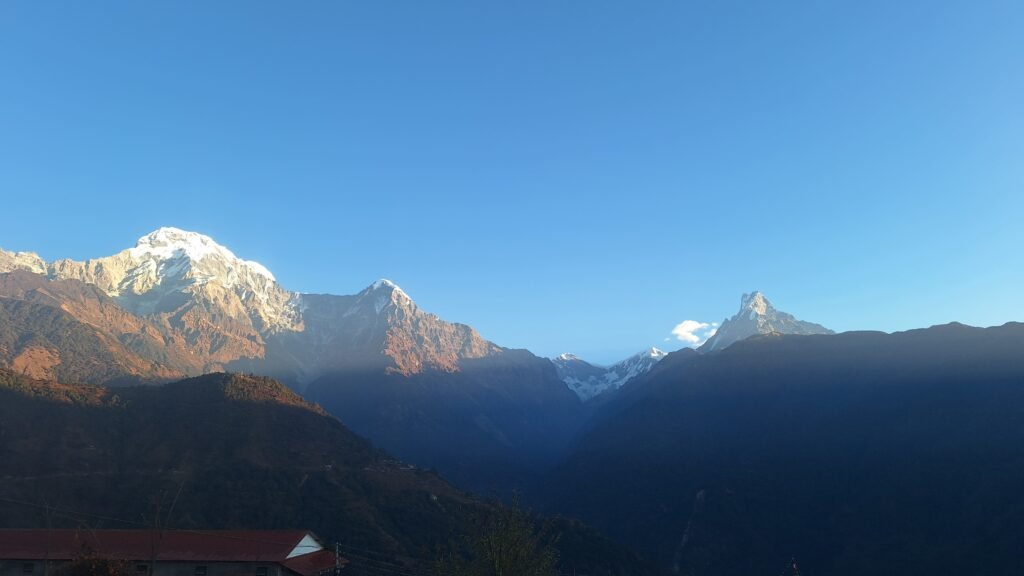When I decided to do the Annapurna Base Camp (ABC) trek, the first big question I had was: when should I go? I started asking other trekkers, reading blogs, and looking at weather charts. I found out that each season in the Annapurna region has its own feel. Some months are full of colour and clear skies. Others bring rain or snow, but also fewer people on the trail.
In this blog, I’ll share what I learned from my experience and from talking to other trekkers along the way. I hope it helps you choose the right time for your own journey.
Spring (March to May)
Spring is one of the most popular times to do the trek, and I can see why. I went in late March, and the weather was nearly perfect. The days were warm, the skies mostly clear, and the rhododendron forests were full of pink and red flowers.
You can walk in a t-shirt during the day and just need a warm jacket at night. The views of Annapurna South, Machapuchare, and Hiunchuli are often sharp and bright in the morning.
There are more trekkers during this time, so the trails and teahouses are busy, but not too crowded. If you enjoy nature, fresh air, and good views, spring is a great time to go.
What to expect:
- Daytime temperature: 10–20°C
- Clear skies in the morning
- Blooming flowers
- Moderate to high number of trekkers
- Dry and stable trails
Summer / Monsoon (June to August)
Summer is also the monsoon season in Nepal. Most people avoid trekking during these months, and I understand why. There’s heavy rainfall almost every day. The trails can be muddy and slippery. Leeches can also be a problem in the lower forest areas.
But I met one trekker who did the trek in July. He said it was quiet, green, and peaceful. The clouds open up sometimes and give you short views of the peaks. If you don’t mind rain and want to avoid the crowds completely, this might work for you.
You’ll need to be careful with your clothing and gear — waterproof boots, rain covers, and quick-drying clothes are a must.
What to expect:
- Daytime temperature: 15–25°C
- High rainfall
- Slippery and muddy trails
- Cloudy views, but very lush landscapes
- Fewer trekkers and quieter lodges
Autumn (September to November)
Autumn is the other peak season for the ABC trek. Many people say it’s the best time to go. I did a short part of the trail in early November on another trip and found the views stunning. The sky was crystal clear in the mornings, and the air felt fresh after the rainy season.
The visibility is excellent, and the days are comfortable for walking. Nights get cold, especially at higher altitudes, so you need warm layers. Since it’s high season, the popular villages like Chhomrong and Deurali can be busy. Booking ahead is a good idea.
The festivals in Nepal during this season also make the experience richer. You might see local celebrations and decorations along the trail.
What to expect:
- Daytime temperature: 10–20°C
- Clear and stable weather
- Sharp mountain views
- Many trekkers on the trail
- Cold nights at higher altitude
Winter (December to February)
I haven’t done the full trek in winter, but I met someone who did it in January. He said it was cold but beautiful. The trails were quiet, the skies were clear, and the mountains looked even more powerful with fresh snow.
The biggest challenge is the cold. It can drop below zero, especially at base camp. You need a proper sleeping bag and warm clothing. Some teahouses may be closed, and snow can block parts of the trail. But if you are well prepared, winter gives you a peaceful and unforgettable trek.
What to expect:
- Daytime temperature: 5–10°C (colder at night)
- Snow at higher elevations
- Crisp, clear views
- Very few trekkers
- Shorter days and limited teahouse options
Final Thoughts
Each season on the Annapurna Base Camp trek has something different to offer. If you want flower-filled forests and mild weather, go in spring. If you prefer clear skies and rich culture, autumn might suit you better. If you don’t mind the cold, winter gives you calm and beauty. And if you love green landscapes and quiet trails, the rainy season could surprise you.
Whatever season you choose, the Annapurna region has a quiet magic that stays with you long after the trek ends.




